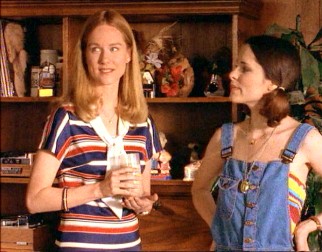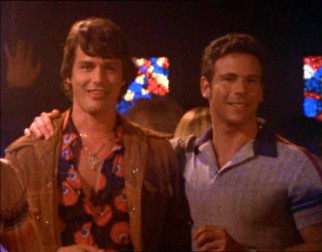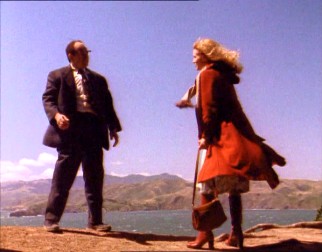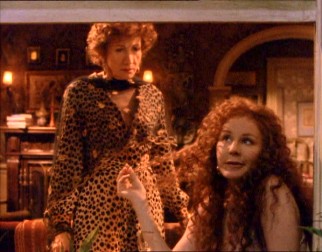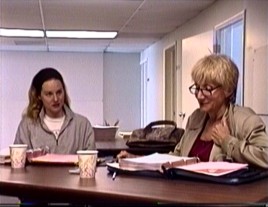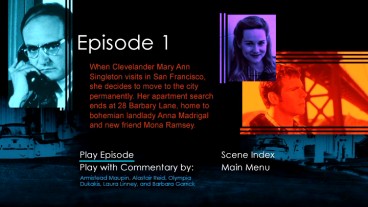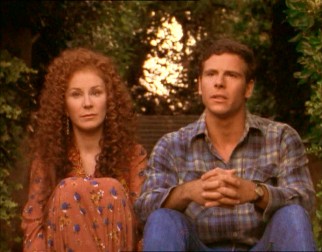"Tales of the City": 20th Anniversary Edition DVD Review
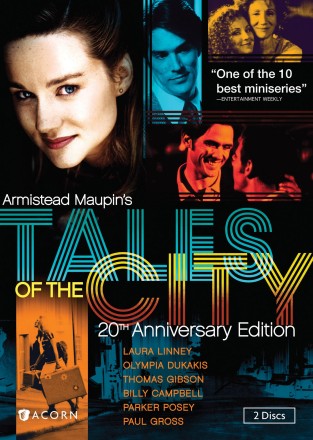 |
Armistead Maupin's Tales of the City (1993)
Series & DVD Details Director: Alastair Reid / Writers: Richard Kramer (screenplay), Armistead Maupin (novel) Executive Producers: Richard Kramer, Armistead Maupin, Tim Bevan, Sigurjon Sighvatsson Regular Cast: Olympia Dukakis (Mrs. Anna Madrigal), Donald Moffat (Edgar Halcyon), Chloe Webb (Margaret Ramsey), Laura Linney (Mary Ann Singleton), Marcus D'Amico (Michael "Mouse" Tolliver), Billy Campbell (Jon Fielden), Thomas Gibson (Beauchamp Day), Paul Gross (Brian Hawkins), Barbara Garrick (DeDe Halcyon Day), Stanley DeSantis (Norman Neal Williams) Recurring Characters: Cynda Williams (D'orothea Wilson), Nina Foch (Frannie Halcyon), Parker Posey (Connie Bradshaw), Meagen Fay (Binky Gruen), Kevin Sessums (Peter Cipriani), Michael Jeter (Carson Callas), Paul Dooley (Herb Tolliver), Belita Moreno (Alice Tolliver), Paul Bartel (Charles Hillary Lord), Lance Loud (William Devereaux Hill III), Bob Mackie (Richard Evan Hampton), Ian McKellen (Archibald Anson Gidde), Country Joe McDonald (Joaquin), Syd Straw (Laurel), Meadow Sisto (Cheryl Moretti) Notable Guest Stars: Edie Adams (Ruby Miller), Robert Downey, Sr. (Edgar's Doctor), McLean Stevenson (Booter Manigault), David Brisbin (Lemon Candles), Lou Liberatore (Chuck), Mary Kay Place (Prue Giroux), Lou Cutell (Herb Siegel), Carolyn Lowery (Hillary), Phillip Moon (Lionel Wong), Karen Black (Herself), John Fleck (Vincent), Elise Neal (Spa Instructress), Armistead Maupin (Writer - uncredited), Amanda Fuller (Lexy), Lucille Bliss (Cable Car Lady), Marissa Ribisi (Receptionist), Arsenio "Sonny" Trinidad (Edsel Ford Fong), Stephanie Faracy (Candi Moretti), Janeane Garofalo (Coppola Woman), Sam Moore (Preacher), Rod Steiger (The Bookshop Owner), Mother Love (Motherly Waitress), Don Novello (Priest), Howard Platt (Mr. Wilson) Running Time: 319 Minutes (6 episodes) / Rating: Not Rated 1.33:1 Fullscreen (Broadcast Ratio), Dolby Stereo 2.0 (English) Subtitles: English for Hearing Impaired; Video Extras Subtitled; Not Closed Captioned UK Airdates: May 8, 1993 - June 12, 1993 / US Airdates: January 10-12, 1994 Suggested Retail Price: $49.99 / DVD Release Date: August 27, 2013 Two single-sided, dual-layered discs (DVD-9s) / Black Eco-Friendly Keepcase in Cardboard Slipcover Previously released as 3-Disc DVD (February 25, 2003) |
Buy Tales of the City: 20th Anniversary Edition DVD at Amazon.com
Today, grown-up television is everywhere you look, even on channels you've never heard of and can't believe are in the original programming business. Twenty years ago, things were much different. HBO had tried adapting Maupin's celebrated series of San Francisco-set novels into a sitcom back in 1982, but it didn't take, with the subscription channel fearing the books' casual treatment of drugs, sex, and sexual orientation wouldn't fly with audiences. It took the backing of the United Kingdom's Channel 4 to make an American television version of this franchise a reality. The six-episode miniseries aired in the UK from May to June 1993 and came to American airwaves via PBS in January 1994. "Tales" would receive Primetime Emmy nominations for Outstanding Miniseries and writing in a miniseries or special (Richard Kramer) but would have to settle for a Peabody and a then easily won GLAAD Media Award.
Two sequel series were made: 1998's "More Tales of the City", a co-production of Channel 4 and Showtime, and 2001's "Further Tales of the City", a purely Showtime creation. All three incarnations of the series starred Academy Award winner Olympia Dukakis and habitual contender Laura Linney.
Linney plays Mary Ann Singleton, a straight-laced and prudish Clevelander who moves to San Francisco in 1976 and is startled by the City by the Bay's loose morals. She finds a "welcome" joint taped to her door the day she moves in to her new place, Though many of the characters are just meeting for the first time, every principal is connected in some way. Mary Ann gets a job working as secretary to Edgar Halcyon (Donald Moffat), a wealthy ad executive who secretly has been given six months to live on failing kidneys. Halcyon begins a relationship with Madrigal, while his co-worker and son-in-law Beauchamp Day (Thomas Gibson, Greg of "Dharma & Greg") takes a liking to Mary Ann. Meanwhile, Mary Ann's coke-snorting, free-spirited neighbor Mona (Sid and Nancy's Chloe Webb) is in an unconventional domestic partnership with Michael "Mouse" Tolliver (Marcus D'Amico), a gay Orlando boy who seems to date a new guy every week.
"Tales of the City" is mature, but not terribly intelligent. Characters are fleshed out and versed in literature. Veteran TV scribe Kramer ("thirtysomething", "My So-Called Life") shows evident care for each of the regulars, even those who seem to drift in and out of view. That care can probably be traced back to the first of Maupin's then five books that were first serialized daily in San Francisco newspapers. Maupin writes what he knows. His outsider's perspective of Northern California reflects his move to San Francisco from the Carolinas at age 26. Having come out shortly thereafter, he's familiar with the gay scene. Each of his characters has an age, an occupation, a hometown, and a secret that emerge naturally in the flow of these human interactions and not out of contrived B storylines.
The series' content must have seemed at least a little shocking for American television, and especially PBS, in 1994, the year that "ER" and "Friends" debuted. There's male kissing, occasional profanity, and a good amount of partial nudity. Compared to the shows that air nowadays on Starz, "Tales" seems more than a little quaint. And yet, some PBS affiliates in southern states pixelated nudity or otherwise edited, delayed or pre-empted the show. Protests about the content from lawmakers and conservative groups appeared to be a factor in PBS' officially finance-based decision not to produce a sequel series despite the record ratings the first batch drew.
Ten years after first bringing it to DVD, Acorn Media recently revisited the series in this 20th Anniversary Edition, which lowers the disc count from 3 to 2, drops a couple of minor text screen-based bonus features, and possibly unveils a newly-uncensored soundtrack.
Disc 1
1. Episode 1 (54:03) (Originally aired May 8, 1993 in the UK; January 10, 1994 in the US)
2. Episode 2 (55:30) (Originally aired May 15, 1993 in the UK; January 10, 1994 in the US)
3. Episode 3 (52:56) (Originally aired May 22, 1993 in the UK; January 11, 1994 in the US)
Disc 2
4. Episode 4 (52:28) (Originally aired May 29, 1993 in the UK; January 11, 1994 in the US)
5. Episode 5 (51:50) (Originally aired June 5, 1993 in the UK; January 12, 1994 in the US)
6. Episode 6 (52:33) (Originally aired June 12, 1993 in the UK; January 12, 1994 in the US)
VIDEO and AUDIO
An unsightly presentation makes "Tales of the City" look and feel much older than its twenty years. The DVD sports some of the worst-looking video I've seen in a really long time and not by any obviously deliberate design. Whether the blame lies in poor production methods or insufficient restoration, the results are most unsatisfactory, resembling a low-grade standard definition stream or even a slightly sharper version of a degraded VHS recorded at a faster speed to maximize tape length. The 1.33:1 picture (which actually measures 1.29:1) is burdened with regular grain that's often heavy and some wear and tear. At its very worst, there is the illusion of snow falling in scenes set indoors. The 2.0 Dolby Stereo soundtracks aren't plagued with problems as noticeable or remarkable, but they too cannot hide their age. The dialogue remains clear and intelligible throughout, plus yellow English SDH subtitles are included should your eardrums disagree. Though the package mentions that "Due to music rights, this program has been modified for home video presentation", the series still makes prominent use of 1970s 'tunes, fitting at least a few Disco Era songs you recognize into just about every episode. While I couldn't tell you the extent of the alterations and online information was tough to come by, I noticed just one instance (an Episode 5 scene with Brian and Michael listening to dueling tunes) where there seemed to be an obvious substitution. The wealth of surviving licensed songs is enough to probably contribute to the steep $49.99 list price. One good thing about this release that I can't personally confirm is that the soundtrack, reportedly censored with some dubbed-over dialogue in the past, is evidently entirely uncensored here.
BONUS FEATURES, MENUS, PACKAGING and DESIGN
Three of the six episodes (1, 3, and 6) are equipped with audio commentary by author Armistead Maupin, British director Alastair Reid, and cast members Olympia Dukakis, Laura Linney, and Barbara Garrick. Disc 2 adds nine clips of behind-the-scenes footage shot on 8mm by director Reid. Featuring table rehearsals, production B-roll, and a first-person set tour, this material adds up to 36 minutes and 34 seconds. It's kind of intriguing and very uncommon to get for a pre-DVD Era series.
Disc 1 opens with a two-minute promo for other Acorn Media properties, many of them British mystery TV series, and individual ads for "Brideshead Revisited": 30th Anniversary Collection and "Queer as Folk": Complete Collection.
Not carried over from Acorn Media's original DVD are on-screen biographies of the cast and Maupin, who also got a bibliography. Everything else here, including the booklet I'll soon discuss, seems to have been reproduced from that release.
Adapted from the cover art and fitted with the end credits theme, the static 16:9 main menus offer individual and successive playback. Each episode gets its own menu with a synopsis and another with scene selection (each episode is divided into six chapters and the final five open with recaps). Some of the text is a bit funky-looking.
The two discs are packaged in a standard black Eco-Box keepcase, the foil cover artwork being reproduced more vibrantly in a glossy cardboard slipcover. Joining the silver platters is a booklet that folds open to eight pages. It includes an 11-year-old reflection from Maupin, a great longer 2002 article (modestly titled "Production Notes") by U.S. producer Alan Poul, and a nifty guide to San Francisco locations and landmarks featured in the series.
CLOSING THOUGHTS
It's kind of tough to believe that "Tales of the City" passed for bold and cutting edge television just twenty years ago. This drama series seems dated today, not merely because it's set in the past or sports woeful picture quality here. Residing between the current spate of daring cable dramas and the relatively hokey fare found on primetime back in the '80s and early '90s, this show remains a fast and easy watch, whose writing, acting, and characters consistently hold your interest.
It's doubtful that Acorn Media's 20th Anniversary Edition improves upon the original DVD release in any greater way than reportedly uncensoring some profanity, but this 2-disc set puts the series back in print and with standard packaging that will save you a couple of keepcases' worth of shelf space. The lowly video is unfortunate and sure to somewhat hinder your enjoyment. Still, it's unlikely the show is revisited again anytime soon and if it didn't look any better now, who's to say it ever can from existing materials?
Buy Tales of the City: 20th Anniversary Edition DVD at Amazon.com
|
Related Reviews:
DVDizzy.com | DVD and Blu-ray Reviews | New and Upcoming DVD & Blu-ray Schedule | Upcoming Cover Art | Search This Site
New: The Ice Storm • Behind the Candelabra • The Iceman • Arthur Newman • Slacker
Written by Armistead Maupin: The Night Listener | Produced by Alan Poul: The Newsroom: The Complete First Season
Laura Linney: Driving Lessons • The Details • The Squid and the Whale • Primal Fear • Arthur Christmas
Billy Campbell: The Rocketeer • The Killing: The Complete First Season • Ghost Town | Parker Posey: Dazed and Confused
San Francisco: Mrs. Doubtfire • The Princess Diaries • Full House: Season 7 • Eli Stone: Season 1 • The Conversation • Zodiac
Runaway Daughters • New York Stories • Life on Mars: The Complete Series • Ebbie
The Murder of Mary Phagan • Tales from Avonlea: Season One • A Single Man • Heidi • Rectify: Season One


